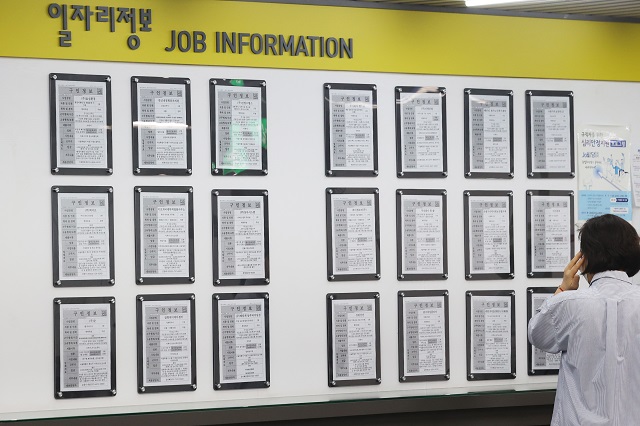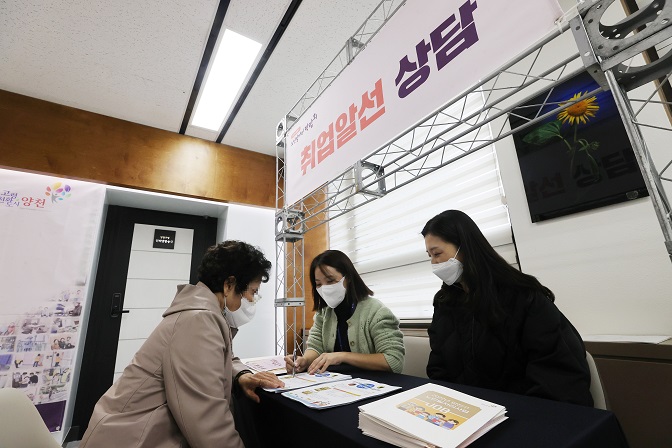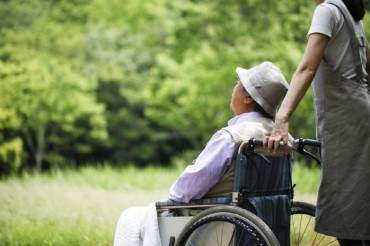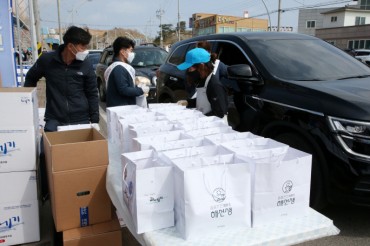
A jobseeker looks at job information posted on a bulletin board at an employment center in western Seoul, in this April 19, 2022, file photo. (Yonhap)
SEOUL, May 11 (Korea Bizwire) — South Korea reported job additions for the 14th consecutive month in April as economic recovery momentum has been extended despite heightened global uncertainty, data showed Wednesday.
The number of employed people came to 28.08 million last month, up 865,000 from a year earlier, according to the data compiled by Statistics Korea.
The April reading was higher than an on-year increase of 831,000 in March and also marked the most job additions for any April since 2000, when the number of employed people grew 1.05 million.
The country has reported job growth every month since March last year as the job market improved amid the economic recovery.
“The job recovery has continued as exports remain robust, and more industries shifted to digitalized and non-contact business operations,” Kong Mi-suk, a senior Statistics Korea official, told reporters.
The finance ministry said the pace of job growth may slow in the coming months due to a high base effect and heightened economic downside risks, such as the war between Russia and Ukraine, and China’s COVID-19 lockdowns of Shanghai and major cities.
The South Korean economy has been on a recovery track on the back of robust exports. But it also faces heightened economic uncertainty due to soaring energy prices caused by Russia’s invasion of Ukraine and the U.S. Federal Reserve’s aggressive monetary tightening.
Jobs data pointed to overall improvements in the labor market, but employment in in-person services, such as accommodations and eateries, fell amid the fast spread of the omicron COVID-19 variant.
Half of the job additions in April were also led by an increase in state-arranged job posts for senior citizens, the data showed.
The employment rate of people aged 15 and older rose 1.7 percentage points on-year to 62.1 percent last month. It marked the highest rate for any April.
The number of economically inactive people — those who are neither working nor actively seeking jobs or people outside the labor force — reached 16.3 million in April, down 376,000 from a year earlier. It marked the 14th consecutive month of an on-year fall.
The jobless rate fell 1 percentage point on-year to 3 percent last month. It was the lowest for any April since June 1999. The number of unemployed people declined 283,000 on-year to 864,000.

A senior citizen (L) receives job consulting at a job fair for the elderly in Seoul, in the file photo taken Nov. 9, 2021. (Yonhap)
By age, job posts for those aged 60 and older grew the most, with 424,000 new positions on-year, due largely to an increase in state-arranged short-term jobs.
By sector, the number of employed people at the health and social welfare service sector grew 230,000, and that in the public administration segment rose 91,000 as the government raised such job posts to prop up the labor market.
The accommodation and food service segment reported job losses for the second straight month due to the fast spread of the omicron variant. The sector saw the number of employed people fall 27,000 on-year in April.
The wholesale and retail sector also reported an on-year drop of 11,000 jobs.
South Korea’s daily COVID-19 cases slowed in April after peaking at over 620,000 in mid-March. But the impact of the virus still weighed on employment in the face-to-face service segments last month.
Job situations for the in-service industries may improve in the coming months as the country lifted almost all social distancing rules on April 18 in its efforts to return to pre-pandemic normalcy.
The manufacturing sector, the backbone of the economy, reported an on-year increase of 132,000 job posts in April amid brisk exports.
The number of permanent workers grew 929,000 on-year in April, and that of temporary workers rose 48,000. But the number of day laborers fell 117,000 on-year, marking the 12th straight month of decline.
In its latest forecast in February, the Bank of Korea (BOK) predicted the number of employed people will increase 280,000 this year, smaller than an on-year increase of 370,000 last year.
President Yoon Suk-yeol has pledged to build business friendly environments and ease regulations for companies in a bid to encourage the private sector to create quality jobs.
Last month, the International Monetary Fund lowered its 2022 growth outlook for the South Korean economy to 2.5 percent while raising its inflation forecast to 4 percent this year.
Concerns about stagflation, a mix of slumping economic growth and high inflation, have arisen as high inflation is feared to erode private spending.
(Yonhap)






